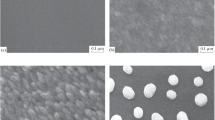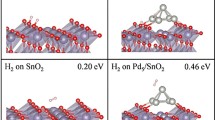Abstract
The decomposition of thin surface oxide films on polycrystalline palladium Pd(poly) at 500–1300 K was investigated by mathematical modeling. This process was analyzed in terms of a model including O2 desorption from the chemisorbed oxygen layer (Oads) and the passage of oxygen inserted under the surface layer of the metal (Oabs) and oxygen dissolved in metal subsurface layers (Odis) to the surface. O2 desorption was modeled on a surface with a square lattice of adsorption sites, with account taken of the energy of the lateral repulsive interactions between adjacent Oads atoms (εaa). At εaa = 10 kJ/mol and when the activation energy of O2 desorption for a chemisorbed-oxygen surface coverage of θ ≈ 0 is E 0des = 230 kJ/mol, the calculated spectra are in agreement with the oxygen temperature-programmed desorption (TPD) spectra obtained for Pd(poly) at θ ≤ 0.5. The passage of Oabs and Odis atoms to the surface was calculated using a first-order equation, with account taken of the activation energy for these atoms coming out to the surface (E 2 and E 3, respectively). As the oxide film is heated, O2 desorption is accompanied by the passage of Oabs and then Odis to the surface, which leads to an increase in the Oads surface coverage and, accordingly, to a buildup of lateral surroundings in the adsorbed layer. Owing to this fact and to the repulsive interactions between Oads atoms, the bonds between Oads and the surface weaken and E des decreases. As a consequence, the O2 desorption rate increases and a low-temperature peak with T max ≈ 710 K, which is due to the passage of Oabs atoms to the surface, and then a high-temperature peak with T max ≈ 770 K, which is due to the passage of Odis atoms to the surface, appear in the TPD spectrum. At εaa = 10 kJ/mol, E 0des = 230 kJ/mol, E 2 = 145 kJ/mol, and E 3 = 160 kJ/mol and when the number of inserted oxygen monolayers is θabs ≤ 0.3 and the number of oxygen monolayers dissolved in subsurface layers is θdis ≤ 10, the TPD spectra calculated for the given model are in agreement with the O2 TPD spectra that are observed for Pd(poly) and are due to the decomposition of surface oxide films.
Similar content being viewed by others
References
www.platinum.matthey.com/applications/
Kummer, J.T., in Catalysts for the Control of Automotive Pollutants, McEvoy, J.E, Ed., Washington, DC: Am. Chem. Soc., 1975.
Anderson, R.B., Stein, K.C., Feenan, J.J., and Hofer, L.J.E., Ind. Eng. Chem., 1961, vol. 53, p. 809.
www.platinum.matthey.com/Johnson, Matthey “Platinum 1999-2012 Interim Review”
Lee, J.H. and Trimm, D.L., Fuel Process. Technol., 1995, vol. 42, p. 339.
Ciuparu, D., Lyubovsky, M.R., Altman, E., Pfefferle, L.D., and Datye, A., Catal. Rev. Sci. Eng., 2002, vol. 44, p. 593.
Veser, G., Ziauddin, M., and Schmidt, L.D., Catal. Today, 1999, vol. 47, p. 219.
Milun, M. and Pervan, P., Surf. Sci., 1989, vol. 218, p. 363.
Banse, B.A. and Koel, B.E., Surf. Sci., 1990, vol. 232, p. 275.
Leisenberger, F.P., Koller, G., Sock, M., Surnev, S., Ramsey, M.G., Netzer, F.P., Klotzer, B., and Hayek, K., Surf. Sci., 2000, vol. 445, p. 380.
Zheng, G. and Altman, E.I., Surf. Sci., 2000, vol. 462, p. 151.
Klotzer, B., Hayek, K., Konvicka, C., Lundgren, E., and Varga, P., Surf. Sci., 2001, vols. 482–485, p.237.
Lundgren, E., Kresse, G., Klein, C., Borg, M., Andersen, J.N., De Santis, M., Gauthier, Y., Konvicka, C., Schmid, M., and Varga, P., Phys. Rev. Lett., 2002, vol. 88, no. 24, pp. 246103–1.
Gabasch, H., Unterberger, W., Hayek, K., Klotzer, B., Kresse, G., Klein, C., Schmid, M., and Varga, P., Surf. Sci., 2006, vol. 600, p. 205.
Kan, H.H., Shumbera, R.B., and Weaver, J.F., Surf. Sci., 2008, vol. 602, p. 1337.
Chang, S.L. and Thiel, P.A., J. Chem. Phys., 1988, vol. 88, p. 2071.
Chang, S.L., Thiel, P.A., and Evans, J.W., Surf. Sci., 1988, vol. 205, p. 117.
Klier, K., Wang, Y.-N., and Simmons, G.W., J. Phys. Chem., 1993, vol. 97, p. 633.
Zheng, G. and Altman, E.I., Surf. Sci., 2002, vol. 504, p. 253.
Todorova, M., Lundgren, E., Blum, V., Mikkelsen, A., Gray, S., Gustafson, J., Borg, M., Rogal, J., Reuter, K., Andersen, J.N., and Scheffler, M., Surf. Sci., 2003, vol. 541, p. 101.
Lundgren, E., Gustafson, J., Mikkelsen, A., and Andersen, J.N., Phys. Rev. Lett., 2004, vol. 92, no. 4, p. 046101-1.
He, J.-W. and Norton, P.R., Surf. Sci., 1988, vol. 204, p. 26.
He, J.-W., Memmert, U., Griffiths, K., and Norton, P.R., J. Chem. Phys., 1989, vol. 90, p. 5088.
Bennett, R.A., Poulston, S., Jones, I.Z., and Bowker, M., Surf. Sci., 1998, vol. 401, p. 72.
Tanaka, H., Yoshinobu, J., and Kawai, M., Surf. Sci., 1995, vol. 327, p. L505.
Todorova, M., Reuter, K., and Scheffler, M., Phys. Rev. B: Condens. Matter, 2005, vol. 71, p. 195403.
Zhdanov, V.P., Surf. Sci., 1981, vol. 111, p. 63.
Salanov, A.N., Titkov, A.I., and Bibin, V.N., Kinet. Catal., 2006, vol. 47, no. 3, p. 430.
Salanov, A.N. and Suprun, E.A., Kinet. Catal., 2010, vol. 51, no. 3, p. 416.
Salanov, A.N. and Suprun, E.A., Kinet. Catal., 2009, vol. 50, no. 1, p. 31.
Salanov, A.N. and Suprun, E.A., Kinet. Catal., 2013, vol. 54, no. 1, p. 106.
Author information
Authors and Affiliations
Corresponding author
Additional information
Original Russian Text © A.N. Salanov, E.A. Suprun, 2016, published in Kinetika i Kataliz, 2016, Vol. 57, No. 2, pp. 259–272.
Rights and permissions
About this article
Cite this article
Salanov, A.N., Suprun, E.A. Mechanism of the decomposition of the surface oxide film on polycrystalline palladium. Kinet Catal 57, 263–275 (2016). https://doi.org/10.1134/S0023158416020129
Received:
Published:
Issue Date:
DOI: https://doi.org/10.1134/S0023158416020129




